Progress in the Development and Implementation of Residential EV Charging Stations Based on Renewable Energy Sources
Abstract
1. Introduction
1.1. Current Needs
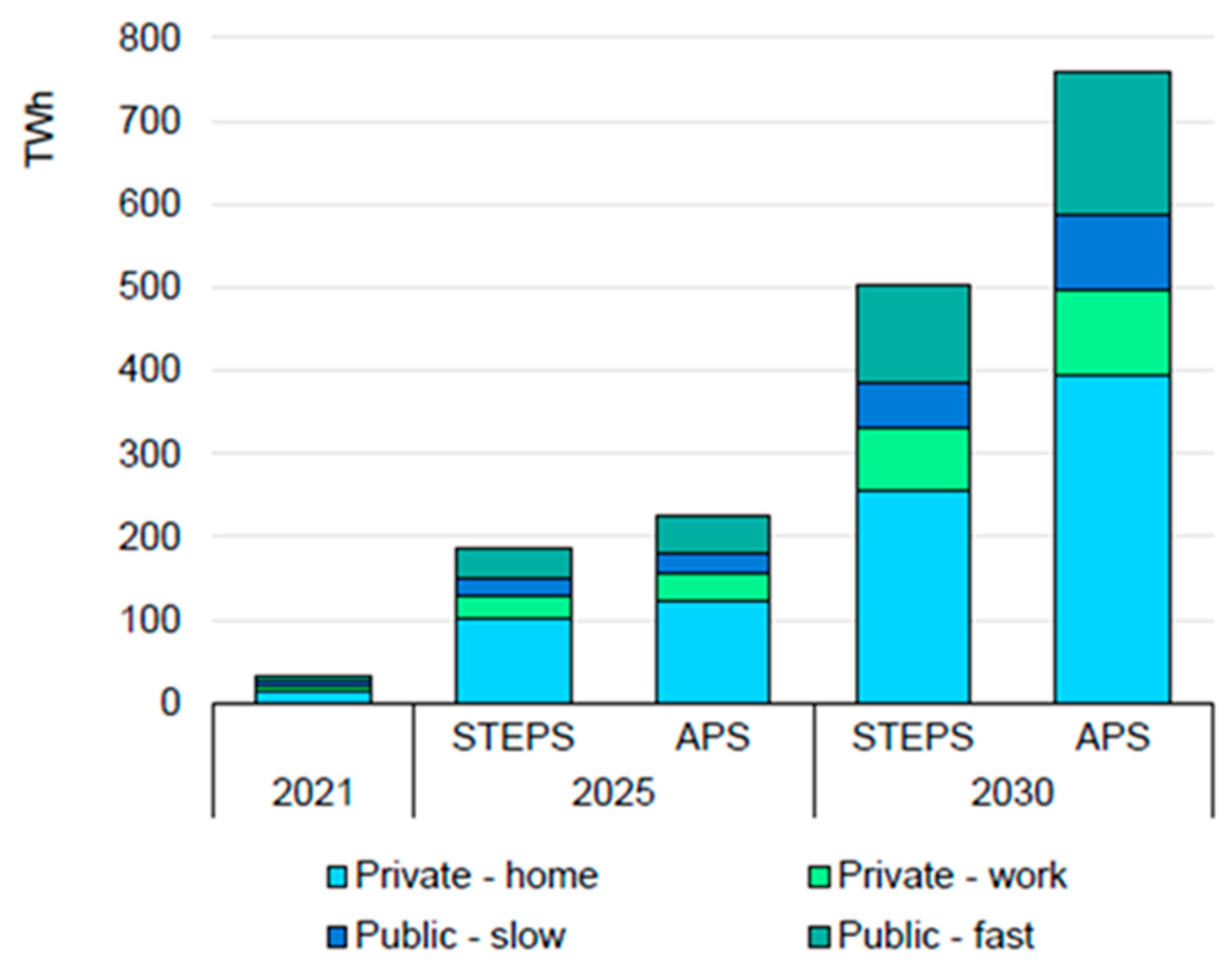
1.2. Technological Developments
1.3. Residential MGs with CSs
2. Hardware Developments
2.1. PVs
2.1.1. Classic PVs
2.1.2. BIPVs
2.2. Storage
2.3. Power Electronics Converters
2.4. Small Wind Turbines
3. Dedicated Software
3.1. Optimization Software
3.1.1. Infrastructure Optimization
- (a)
- an EV as a load almost doubles the consumption of electricity of a residence. Self-RES-based electricity is then useful.
- (b)
- Adding a BESS makes sense by providing additional flexibility for the EV charging process.
- (c)
- A presented PV + BESS + EV system modelling algorithm shows a maximisation of self-consumption and decreased overall grid electricity exchange by a factor of two.
- (d)
- An optimal charging station with a BESS achieves a two-fold better ROI (return of investment) than a PV station only. This result was obtained considering 2016 prices.
3.1.2. Charging Optimization
3.1.3. Smart Grids Optimization
3.2. Economics and Management
4. Charging Strategies, Standards and Incentives
4.1. Charging Strategies
4.2. Charging Standards
- -
- “Pre-cabling should be installed for every parking space in residential buildings;
- -
- charging points should be capable of smart charging and, where appropriate, bidirectional charging;
- -
- non-proprietary and non-discriminatory approach towards communication protocols and standards.”
4.3. Policies and Incentives
5. Design of Residential MG with EV Charging Capabilities
6. Case Studies
7. Conclusions
Funding
Data Availability Statement
Conflicts of Interest
References
- Shaw, R.; Luo, Y.; Cheong, T.S.; Abdul Halim, S.; Chaturvedi, S.; Hashizume, M.; Insarov, G.E.; Ishikawa, Y.; Jafari, M.; Kitoh, A.; et al. Sixth Assessment Report of the Climate Change 2022, IPCC; Cambridge University Press: Cambridge, UK; New York, NY, USA, 2022; pp. 1457–1579. ISBN 978-92-9169-160-9. [Google Scholar]
- The 2021 Digital Auto Report—Strategy—PwC. Available online: https://www.strategyand.pwc.com (accessed on 17 September 2022).
- Global EV Outlook 2019, Scaling-Up the Transition to Electric Mobility, IEA, May 2019. Available online: https://www.iea.org/reports/global-ev-outlook-2019 (accessed on 17 March 2022).
- EV Charging Technologies, Global Market Analysis and Forecasts of EV Charging Equipment: 2022–2031, Guidehouse Insights. Available online: https://guidehouseinsights.com (accessed on 4 November 2022).
- Maisch, M. High-Voltage Battery Cathode for Longer Driving Ranges. PV Magazine, 14 September 2022. [Google Scholar]
- Basundhara Dutta. The Chicken or the Egg? Available online: https://www.energymanagementcentre.eu/research/emc-working-papers/the-chicken-or-the-egg/ (accessed on 18 June 2022).
- Global EV Outlook 2022, Securing Supplies for An Electric Future, International Energy Agency. Available online: www.iea.org (accessed on 10 September 2022).
- Why the Automotive Future is Electric, McKinsey Center for Future Mobility. Available online: https://www.mckinsey.com. (accessed on 22 September 2021).
- Analyst Insight: Residential Energy Storage Deployments Skyrocket, Guidehouse Insights. Available online: https://guidehouseinsights.com (accessed on 26 October 2022).
- Marinescu, C. Design Consideration Regarding a Residential Renewable-Based Microgrid with EV Charging Station Capabilities. Energies 2021, 14, 5085. [Google Scholar] [CrossRef]
- Kampshoff, P.; Kumar, A.; Peloquin, S.; Sahdev, S. Building the Electric-Vehicle Charging Infrastructure, America Needs; McKinsey & Company: Tokyo, Japan, 2022; Available online: https://www.mckinsey.com (accessed on 24 October 2022).
- Ahadi, A.; Sarma, S.; Moon, J.S.; Kang, S.; Lee, J.-H. A Robust Optimization for Designing a Charging Station Based on Solar and Wind Energy for Electric Vehicles of a Smart Home in Small Villages. Energies 2018, 11, 1728. [Google Scholar] [CrossRef]
- Habeeb, S.A.; Tostado-Véliz, M.; Hasanien, H.M.; Turky, R.A.; Meteab, W.K.; Jurado, F. DC Nanogrids for Integration of Demand Response and Electric Vehicle Charging Infrastructures: Appraisal, Optimal Scheduling and Analysis. Electronics 2021, 10, 2484. [Google Scholar] [CrossRef]
- Hadero, M.; Khan, B. Development of DC Microgrid Integrated Electric Vehicle Charging Station With Fuzzy Logic Controller. Front. Energy Res. 2022, 10, 922384. [Google Scholar] [CrossRef]
- Menniti, D.; Pinnarelli, A.; Sorrentino, N.; Vizza, P.; Barone, G.; Brusco, G.; Mendicino, S.; Mendicino, L.; Polizzi, G. Enabling Technologies for Energy Communities: Some Experimental Use Cases. Energies 2022, 15, 6374. [Google Scholar] [CrossRef]
- John, R.V.; Gautam, R.; Kumar, M. Power Flow Management and BESS Design Consideration for Solar PV fed Isolated DC Microgrid for Residential Applications. In Proceedings of the 2022 IEEE Delhi Section Conference (DELCON), New Delhi, India, 11–13 February 2022. [Google Scholar]
- Nasir, M.; Khan, H.A.; Zaffar, N.A.; Vasquez, J.C.; Guerrero, J.M. Scalable Solar dc Microgrids, Scalable solar dc micrigrids: On the path to revolutionizing the electrification architecture of developing communities. IEEE Electrif. Mag. 2018, 6, 63–72. [Google Scholar] [CrossRef]
- Bhatti, A.R.; Salam, Z.; Abdul, M.J.B.; Yee, K.P. A Comprehensive Overview of Electric Vehicle Charging using Renewable Energy. Int. J. Power Electron. Drive Syst. 2016, 7, 114–123. [Google Scholar] [CrossRef]
- Bhatti, A.R.; Salam, Z.; Aziz, M.J.B.A.; Yee, K.P. A critical review of electric vehicle charging using solar Photovoltaic. Int. J. Energy Res. 2016, 40, 439–461. [Google Scholar] [CrossRef]
- Green, M.A.; Emery, K.; Bücher, K.; King, D.L. Solar cell efficiency tables (Version 60). Prog. Photovolt. 1995, 3, 229–233. [Google Scholar] [CrossRef]
- Bellini, E. Recom Launches Bifacial Heterojunction Solar Panel with 395 W Output. PV Magazine, 21 October 2022. [Google Scholar]
- Trends in Photovoltaic Applications; IEA: Paris, France, 2022; Available online: https://iea-pvps.org, (accessed on 1 November 2022).
- Boxwell, M. Solar Energy Handbook; Greenstream Publishing: London, UK, 2019. [Google Scholar]
- Bhatti, A.R.; Salam, Z.; Aziz, M.J.B.A.; Yee, K.P.; Ashique, R.H. Electric vehicles charging using photovoltaic: Status and technological review. Renew. Sustain. Energy Rev. 2016, 54, 34–47. [Google Scholar] [CrossRef]
- Li, Y.; Gao, W.; Ruan, Y. Performance investigation of grid-connected residential PV-battery system focusing on enhancing self-consumption and peak shaving in Kyushu, Japan. Renew. Energy 2018, 127, 514–523. [Google Scholar] [CrossRef]
- Cucchiella, F.; D’adamo, I.; Gastaldi, M. Photovoltaic energy systems with battery storage for residential areas:an economic analysis. J. Clean. Prod. 2016, 131, 460–474. [Google Scholar] [CrossRef]
- Schwartz, E.K.; Krarti, M. Review of Adoption Status of Sustainable Energy Technologies in the US Residential Building Sector. Energies 2022, 15, 2027. [Google Scholar] [CrossRef]
- Wu, W.; Skye, H.M. Residential net-zero energy buildings: Review and perspective. Renew. Sustain. Energy Rev. 2021, 142, 110859. [Google Scholar] [CrossRef] [PubMed]
- Rodríguez-Gómez, F.; del Campo-Ávila, J.; Ferrer-Cuesta, M.; Mora-López, L. Data driven tools to assess the location of photovoltaic facilities in urban areas. Expert Syst. Appl. 2022, 203, 117349. [Google Scholar] [CrossRef]
- Biyik, E.; Araz, M.; Hepbasli, A.; Shahrestani, M.; Yao, R.; Shao, L.; Essah, E.; Oliveira, A.; del Caño, T.; Rico, E.; et al. A key review of building integrated photovoltaic (BIPV) systems. Eng. Sci. Technol. Int. J. 2017, 20, 833–858. [Google Scholar] [CrossRef]
- Molnár, G.; Ürge-Vorsatz, D.; Chatterjee, S. Estimating the global technical potential of building-integrated solar energy production using a high-resolution geospatial model. J. Clean. Production 2022, 375, 134133. [Google Scholar] [CrossRef]
- Magrini, A.; Lentini, G.; Cuman, S.; Bodrato, A.; Marenco, L. From nearly zero energy buildings (NZEB) to positive energy buildings(PEB): The next challenge–The most recent European trends with some notes on the energy analysis of a forerunner PEB example. Dev. Built Environ. 2020, 3, 100019. [Google Scholar] [CrossRef]
- Residential Distributed Energy Resources. Guidehouse Insights Forecasts. Available online: https://guidehouseinsights.com (accessed on 21 October 2022).
- Li, Z.; Ma, T.; Li, S.; Gu, W.; Lu, L.; Yang, H.; Dai, Y.; Wang, R. Producible, and Colored Solar Photovoltaics Enabled by Self-Assembled Photonic Glass. CS Nano 2022, 16, 11473–11482. [Google Scholar] [CrossRef]
- Research Consortium Develops «Highly Intelligent Factory» for Energetic Building Renovation, Photon Newsletter. Available online: https://www.photon.info/en (accessed on 21 July 2022).
- Enkhardt, S. Photovoltaic-Thermal Solar Tiles. PV Magazine, 21 October 2022. [Google Scholar]
- Carroll, D. Australian Manufacturer Unveils Solar Tile with 19.3% Efficiency. PV Magazine, 21 October 2022. [Google Scholar]
- Yu, J.C.; Li, B.; Dunn, C.J.; Yan, J.; Diroll, B.T.; Chesman, A.S.; Jasieniak, J.J. High-Performance and Stable Semi-Transparent Perovskite Solar Cells through Composition Engineering. Adv. Sci. 2022, 9, 2201487. [Google Scholar] [CrossRef]
- Maturi, L.; Belluardo, G.; Moser, D.; Del Buono, M. BiPV system performance and efficiency drops: Overview on PV module temperature conditions of different module types. Energy Procedia 2014, 48, 1311–1319. [Google Scholar] [CrossRef]
- Al Wahedi, A.; Bicer, Y. Development of an off-grid electrical vehicle charging station hybridized with renewables including battery cooling system and multiple energy storage units. Energy Rep. 2020, 6, 2006–2021. [Google Scholar] [CrossRef]
- Matich, B. Historical and Landmarked Buildings Turn to Solar Amid Changing Policies, Rising Prices. PV Magazine, 27 August 2022. [Google Scholar]
- Chen, T.; Tai, K.F.; Raharjo, G.P.; Heng, C.K.; Leow, S.W. A novel design approach to prefabricated BIPV walls for multi-storey buildings. J. Build. Eng. 2023, 63, 105469. [Google Scholar] [CrossRef]
- Kennedy, R. California Energy Commission awards Grant for Low-Income Multifamily Solar and Storage Project. PV Magazine, 30 August 2022. [Google Scholar]
- Available online: https://www.made-in-china.com/multi-search/Li-ion%2BBattery%2BPrice%2Bbyd/F1/2.html (accessed on 15 November 2021).
- Available online: https://www.thisoldhouse.com/solar-alternative-energy/reviews/tesla-powerwall-cost (accessed on 24 October 2022).
- Hoppmann, J.; Volland, J.; Schmidt, T.S.; Hoffmann, V.H. The economic viability of battery storage for residential solar photovoltaic systems—A review and a simulation model. Renew. Sustain. Energy Rev. 2014, 39, 1101–1118. [Google Scholar] [CrossRef]
- Lichner, C. Energy Storage Efficiency and Prices Determine Economics. PV Magazine, 16 July 2022. [Google Scholar]
- Chadly, A.; Azar, E.; Maalouf, M.; Mayyas, A. Techno-economic analysis of energy storage systems using reversible fuel cells and rechargeable batteries in green buildings. Energy 2022, 247, 123466. [Google Scholar] [CrossRef]
- Parmeshwarappa, P.; Gundlapalli, R.; Jayanti, S. Power and Energy Rating Considerations in Integration of Flow Battery with Solar PV and Residential Load. Batteries 2021, 7, 62. [Google Scholar] [CrossRef]
- Ali, A.; Shakoor, R.; Raheem, A.; Muqeet, H.A.U.; Awais, Q.; Khan, A.A.; Jamil, M. Latest Energy Storage Trends in Multi-Energy Standalone Electric Vehicle Charging Stations: A Comprehensive Study. Energies 2022, 15, 4727. [Google Scholar] [CrossRef]
- Graebig, M.; Röder, S.; Erdmann, G. Assessment of Residential Battery Systems (rbs): Profitability, Perceived Value Proposition, and Potential Business Models. 2014. Available online: https://www.semanticscholar.org/paper/Assessment-of-Residential-Battery-Systems-(RBS) (accessed on 18 October 2022).
- El-Bayeh, C.Z.; Alzaareer, K.; Aldaoudeyeh, A.M.; Brahmi, B.; Zellagui, M. Charging and Discharging Strategies of Electric Vehicles: A Survey. World Electr. Veh. J. 2021, 12, 11. [Google Scholar] [CrossRef]
- Cucchiella, F.; D’Adamo, I.; Gastaldi, M.; Stornelli, V. Solar Photovoltaic Panels Combined with Energy Storage in a Residential Building: An Economic Analysis. Sustainability 2018, 10, 3117. [Google Scholar] [CrossRef]
- Puranen, P.; Kosonen, A.; Ahola, J. Techno-economic viability of energy storage concepts combined with a residential solar photovoltaic system: A case study from Finland. Appl. Energy 2021, 298, 117199. [Google Scholar] [CrossRef]
- Shavolkin, O. Improvement of the Grid-Tied Solar-Wind System with a Storage Battery for the Self-Consumption of a Local Object . Energies 2022, 15, 5114. [Google Scholar] [CrossRef]
- Kennedy, R. Sunnova to Develop Solar, Storage ‘Micro-Utility’ in California. PV Magazine, 9 September 2022. [Google Scholar]
- Available online: https://www.productopia.com/shopping?q=tesla%20powerwall%20price%202022 (accessed on 9 November 2022).
- Bellini, E. Meritsun Unveils 15 kWh Lithium-ion Battery for Residential Applications. PV Magazine, 7 September 2022. [Google Scholar]
- Bellini, E. Simpliphi Presents Integrated Storage Solution for Rooftop PV. PV Magazine, 7 November 2022. [Google Scholar]
- Green, J.; Newman, P.; Forse, N. RENeW Nexus: Enabling Resilient, Low Cost & Localised Electricity Markets through Blockchain P2P & VPP Trading; Power Ledger and Curtin University: Perth, Australia, 2020. [Google Scholar]
- Ahmad, F.; Khalid, M.; Panigrahi, B.K. Development in Energy Storage System for Electric Transportation: A Comprehensive Review. Elsevier-J. Energy Storage 2021, 43, 103153. [Google Scholar] [CrossRef]
- Mey, F.; Hicks, J. Community Owned Renewable Energy: Enabling the Transition towards Renewable Energy? In Decarbonising the Built Environment: Charting the Transition; Newton, P., Prasad, D., Sproul, A., White, S., Eds.; Palgrave Macmillan: London, UK, 2019. [Google Scholar]
- Available online: https://energy.ec.europa.eu/topics/markets-and-consumers/energy-communities_en (accessed on 17 November 2022).
- Cormac, G.; Shaunagh, R.M.M.; He, S. Module Level Power Electronics. S&P. Available online: https://www.spglobal.com/commodityinsights/en (accessed on 23 August 2022).
- Bellini, E.; Enkhardt, S. New Hybrid Inverter for Rooftop PV Arrays from SMA. PV Magazine, 19 January 2022. [Google Scholar]
- Bellini, E. New Residential Hybrid Inverter Series. PV Magazine, 28 September 2022. [Google Scholar]
- Bellini, E. Single-Phase Inverters for Residential PV. PV Magazine, 28 September 2022. [Google Scholar]
- Gupta, U. Statcon Energiaa Launches Plug-and-Play Microgrid Inverter Solution. PV Magazine, 7 October 2022. [Google Scholar]
- Gupta, U. Wall-Mountable Inverters for Residential Solar. PV Magazine, 11 October 2022. [Google Scholar]
- Bellini, E. Canadian Solar Presents All-in-One Residential Battery Inverter Solution. PV Magazine, 22 September 2022. [Google Scholar]
- Khalid, M.; Ahmad, F.; Panigrahi, B.J.; Al-Fagih, L. A Comprehensive Review on Advanced Charging Topologies and Methodologies for Electric Vehicle Battery. Elsevier-J. Energy Storage 2022, 53, 105084. [Google Scholar] [CrossRef]
- 2017 Small Wind World Report; WWEA: Bonn, Germany, 2017; Available online: http://www.wwindea.org/ (accessed on 12 October 2018).
- Orrell, A.; Sheridan, L.; Kazimierczuk, K. Distributed Wind Market Report; UD DOE. Available online: https://www.energy.gov (accessed on 29 August 2021).
- Tummala, A.; Velamati, R.K.; Sinha, D.K.; Indraja, V.; Krishna, V.H. A review on small scale wind turbines. Renew. Sustain. Energy Rev. 2016, 56, 1351–1371. [Google Scholar] [CrossRef]
- Kumar, R.; Raahemifar, K.; Fung, A.S. A critical review of vertical axis wind turbines for urban applications. Renew. Sustain. Energy Rev. 2018, 89, 281–291. [Google Scholar] [CrossRef]
- Mahesh, A.; Sandhu, K.S. Hybrid wind/photovoltaic energy system developments: Critical review and findings. Renew. Sustain. Energy Rev. 2015, 52, 1135–1147. [Google Scholar] [CrossRef]
- Akour, S.N.; Al-Heymari, M.; Ahmed, T.; Khalil, K.A. Experimental and theoretical investigation of micro wind turbine for low wind speed regions. Renew. Energy 2018, 116, 215–223. [Google Scholar] [CrossRef]
- Schoeck, M. Rooftop Mounted Microgrid Combines Wind, Solar, Storage. PV Magazine, 7 November 2022. [Google Scholar]
- Hanley, S. Aeromine Rooftop Wind Technology Outperforms Solar, 19 October 2022. Available online: https://cleantechnica.com/2022/10/19/ (accessed on 17 October 2022).
- Hoarau, Q.; Perez, Y. Interactions between electric mobility and photovoltaic generation: A Review. Renew. Sustain. Energy Rev. 2018, 94, 510–522. [Google Scholar] [CrossRef]
- Alsadi, S.; Khatib, T. Photovoltaic Power Systems Optimization Research Status: A Review of Criteria, Constrains, Models, Techniques, and Software Tools. Appl. Sci. 2018, 8, 1761. [Google Scholar] [CrossRef]
- Brozynski, M.T.; Leibowicz, B.D. A multi-level optimization model of infrastructure-dependent technology adoption: Overcoming the chicken-and-egg problem. Eur. J. Oper. Res. 2022, 300, 755–770. [Google Scholar] [CrossRef]
- Yang, Y.; Wei, Q.; Liu, S.; Zhao, L. Distribution Strategy Optimization of Standalone Hybrid WT/PV System Based on Different Solar and Wind Resources for Rural Applications. Energies 2022, 15, 5307. [Google Scholar] [CrossRef]
- Mohamed, A.A.; El-Sayed, A.; Metwally, H.; Selem, S.I. Grid integration of a PV system supporting an EV charging station using Salp Swarm Optimization. Sol. Energy 2020, 205, 170–182. [Google Scholar] [CrossRef]
- Leijon, J.; Boström, C. Charging Electric Vehicles Today and in the Future. World Electr. Veh. J. 2022, 13, 139. [Google Scholar] [CrossRef]
- Fachrizal, R.; Shepero, M.; van der Meer, D.; Munkhammar, J.; Widén, J. Smart charging of electric vehicles considering photovoltaic power production and electricity consumption: A review. eTransportation 2020, 4, 100056. [Google Scholar] [CrossRef]
- Petrusic, A.; Janjic, A. Renewable Energy Tracking and Optimization in a Hybrid Electric Vehicle Charging Station. Appl. Sci. 2021, 11, 245. [Google Scholar] [CrossRef]
- van der Kam, M.; van Sark, W. Smart charging of electric vehicles with photovoltaic power and vehicle-to-grid technology in a microgrid; a case study. Appl. Energy 2015, 152, 20–30. [Google Scholar] [CrossRef]
- Huang, P.; Munkhammar, J.; Fachrizal, R.; Lovati, M.; Zhang, X.; Sun, Y. Comparative studies of EV fleet smart charging approaches for demand response in solar-powered building communities. Sustain. Cities Soc. 2022, 85, 104094. [Google Scholar] [CrossRef]
- Torres-Sanz, V.; Sanguesa, J.A.; Martinez, F.J.; Garrido, P.; Marquez-Barja, J.M. Enhancing the Charging Process of Electric Vehicles at Residential Homes. IEEE Access. 2018, 6, 22875–22888. [Google Scholar] [CrossRef]
- Li, Y.; Li, K. Incorporating demand response of electric vehicles in scheduling of isolated microgrids with renewables using a bi-level programming approach. arXiv 2019, arXiv:1908.11197. [Google Scholar] [CrossRef]
- El-Hendawi, M.; Wang, Z.; Paranjape, R.; Pederson, S.; Kozoriz, D.; Fick, J. Electric Vehicle Charging Model in the Urban Residential Sector. Energies 2022, 15, 4901. [Google Scholar] [CrossRef]
- Turker, H.; Bacha, S. Optimal Minimization of Plug-In Electric Vehicle Charging Cost With Vehicle-to-Home and Vehicle-to-Grid Concepts. IEEE Trans. Veh. Technol. 2018, 67, 10281–10292. [Google Scholar] [CrossRef]
- Dvoršak, B.; Havelka, J.; Mainardi, E.; Pandžić, H.; Selič, T.; Tretinjak, M. Smart Home Systems. Available online: https://ec.europa.eu/programmes/erasmus-plus/project-result-content (accessed on 12 November 2022).
- Kong, X.; Sun, B.; Kong, D.; Li, B. Home energy management optimization method considering potential risk cost. Sustain. Cities Soc. 2020, 62, 102378. [Google Scholar] [CrossRef]
- Abushnaf, J. Smart Home Energy Management: An Analysis of a Novel Dynamic Pricing and Demand Response Aware Control Algorithm for Households with Distributed Renewable Energy Generation and Storage. Available online: https://ro.ecu.edu.au/theses/1982 (accessed on 12 November 2022).
- Paterakis, N.G.; Erdinç, O.; Pappi, I.N.; Bakirtzis, A.G.; Catalão, J.P. Coordinated Operation of a Neighborhood of Smart Households Comprising Electric Vehicles, Energy Storage and Distributed Generation. IEEE Trans. Smart Grid 2016, 7, 2736–2747. [Google Scholar] [CrossRef]
- Foroozandeh, Z.; Ramos, S.; Soares, J.; Vale, Z. Optimal Contract Power and Battery Energy Storage System Capacity for Smart Buildings. In Proceedings of the 2021 IEEE PES Innovative Smart Grid Technologies Europe (ISGT Europe), Espoo, Finland, 18–21 October 2021. [Google Scholar]
- Koirala, B.P. Integrated Community Energy Systems. Ph.D. Thesis, University of Delft, Delft, The Netherlands, 2017. [Google Scholar]
- Worighi, I.; Geury, T.; El Baghdadi, M.; Van Mierlo, J.; Hegazy, O.; Maach, A. Optimal Design of Hybrid PV-Battery System in Residential Buildings: End-User Economics, and PV Penetration. Appl. Sci. 2019, 9, 1022. [Google Scholar] [CrossRef]
- Zafar, U.; Bayhan, S.; Sanfilippo, A. Home Energy Management System Concepts, Configurations, and Technologies for the Smart Grid. IEEE Access 2020, 8, 119271–119286. [Google Scholar] [CrossRef]
- Farrokhifar, M.; Aghdam, F.H.; Alahyari, A.; Monavari, A.; Safari, A. Optimal energy management and sizing of renewable energy and battery systems in residential sectors via a stochastic MILP model. Electr. Power Syst. Res. 2020, 187, 106483. [Google Scholar] [CrossRef]
- Diaz-Londono, C.; Vuelvas, J.; Gruosso, G.; Correa-Florez, C.A. Remuneration Sensitivity Analysis in Prosumer and Aggregator Strategies by Controlling Electric Vehicle Chargers. Energies 2022, 15, 6913. [Google Scholar] [CrossRef]
- Azaroual, M.; Ouassaid, M.; Maaroufi, M. Model Predictive Control and Optimal Cost for A Grid-Connected Photovoltaic/Wind/Battery System. In Proceedings of the 2020 5th International Conference on Renewable Energies for Developing Countries (REDEC), Marrakech, Morocco, 29–30 June 2020. [Google Scholar]
- Chakir, A.; Abid, M.; Tabaa, M.; Hachimi, H. Demand-side management strategy in a smart home using electric vehicle and hybrid renewable energy system. Energy Rep. 2022, 8, 383–393. [Google Scholar] [CrossRef]
- Odkhuu, N.; Lee, K.B.; AAhmed, M.; Kim, Y.C. Optimal Energy Management of V2B with RES and ESS for Peak Load Minimization. Appl. Sci. 2018, 8, 2125. [Google Scholar] [CrossRef]
- Dengiz, T.; Jochem, P.; Fichtner, W. Demand response through decentralized optimization in residential areas with wind and photovoltaics. Energy 2021, 223, 119984. [Google Scholar] [CrossRef]
- Gupta, R.S.; Tyagi, A.; Anand, S. Optimal allocation of electric vehicles charging infrastructure, policies and future trends. J. Energy Storage 2021, 43, 103291. [Google Scholar] [CrossRef]
- Lebrouhi, B.E.; Khattari, Y.; Lamrani, B.; Maaroufi, M.; Zeraouli, Y.; Kousksou, T. Key challenges for a large-scale development of battery electric vehicles: A comprehensive review. J. Energy Storage 2021, 44, 103273. [Google Scholar] [CrossRef]
- Hajar, K.; Guo, B.; Hably, A.; Bacha, S. Smart charging impact on electric vehicles in presence of Photovoltaics. In Proceedings of the 2021 22nd IEEE International Conference on Industrial Technology (ICIT), Valencia, Spain, 10–12 March 2021. [Google Scholar]
- Mazzeo, D. Nocturnal electric vehicle charging interacting with a residential photovoltaic-battery system: A 3E (energy, economic and environmental) analysis. Energy 2019, 168, 310–331. [Google Scholar] [CrossRef]
- Barhagh, S.S.; Abapour, M.; Mohammadi-Ivatloo, B. Optimal scheduling of electric vehicles and photovoltaic systems in residential complexes under real-time pricing mechanism. J. Clean. Prod. 2020, 246, 119041. [Google Scholar] [CrossRef]
- Fathabadi, H. Novel grid-connected solar/wind powered electric vehicle charging station with vehicle-to-grid technology. Energy 2017, 132, 1–11. [Google Scholar] [CrossRef]
- Fathabadi, H. Novel wind powered electric vehicle charging station with vehicle-to-grid (V2G) connection capability. Energy Convers. Manag. 2017, 136, 229–239. [Google Scholar] [CrossRef]
- Das, H.S.; Rahman, M.M.; Li, S.; Tan, C.W. Electric vehicles standards, charging infrastructure, and impact on grid integration: A technological review. Renew. Sustain. Energy Rev. 2020, 120, 109618. [Google Scholar] [CrossRef]
- Vijayakumar, S.; Sudhakar, N. A review on unidirectional converters for on-board chargers in electric vehicle. Front. Energy Res. 2022. [Google Scholar] [CrossRef]
- Recast of Energy Performance of Buildings Directive, (EPBD), Position Paper. Available online: www.acea.auto (accessed on 13 October 2022).
- The Breakthrough Agenda Report, Accelerating Sector Transitions Through Stronger International Collaboration; IEA, IRENA: Paris, France, 2022; Available online: https://www.irena.org (accessed on 10 October 2022).
- Hensley, R. Scaling Electric-Vehicle Infrastructure to Meet Demand; McKinsey: Tokyo, Japan, 2022; Available online: https://www.mckinsey.com (accessed on 21 October 2022).
- Capturing Growth in Asia’s Emerging EV Ecosystem; McKinsey: Tokyo, Japan, 2022. Available online: https://www.mckinsey.com (accessed on 7 October 2022).
- Available online: https://blog.wallbox.com/ev-incentives-europe-guide/ (accessed on 25 November 2022).
- Haffaf, A.; Lakdja, F.; Ould Abdeslam, D. Experimental performance analysis of an installed microgrid-based PV/battery/EV grid-connected system. Clean Energy 2022, 6, 599–618. [Google Scholar] [CrossRef]
- Li, J. Optimal sizing of grid-connected photovoltaic battery systems for residential houses in Australia. Renew. Energy 2019, 136, 1245–1254. [Google Scholar] [CrossRef]
- Mohamed, A.M.; Mohamed, F.M. Design and Simulate an Off-Grid PV System with a Battery Bank for EV Charging. Univers. J. Electr. Electron. Eng. 2020, 7, 273–288. [Google Scholar] [CrossRef]
- Anoune, K.; Bouya, M.; Astito, A.; Abdellah, A.B. Design and sizing of a Hybrid PV-Wind-Grid System for Electric Vehicle Charging Platform. MATEC Web Conf. 2018, 8. [Google Scholar] [CrossRef][Green Version]
- Fischer, A. Fully operational residential microgrid will help power exhibits at RE+. PV Magazine, 7 September 2022. [Google Scholar]
- Weaver, J.F. Accessorize your rooftop PV with batteries, panels, and EV chargers, Solar 101 series. PV Magazine, 8 July 2021. [Google Scholar]
- Regulatory Environment and Incentives for Using Electric Vehicles and Developing a Charging Infrastructure. Available online: https://www.bmwk.de (accessed on 9 October 2022).
- Fuhs, M. Overview of Home Charging Stations in Germany. PV Magazine, 11 February 2022. [Google Scholar]
- Fuhs, M. Charging with Solar at Home. PV Magazine, 19 February 2022. [Google Scholar]
- LichtBlick_Prosumer-Report 2022, Hamburg June 2022. Available online: https://www.lichtblick.de (accessed on 10 September 2022).
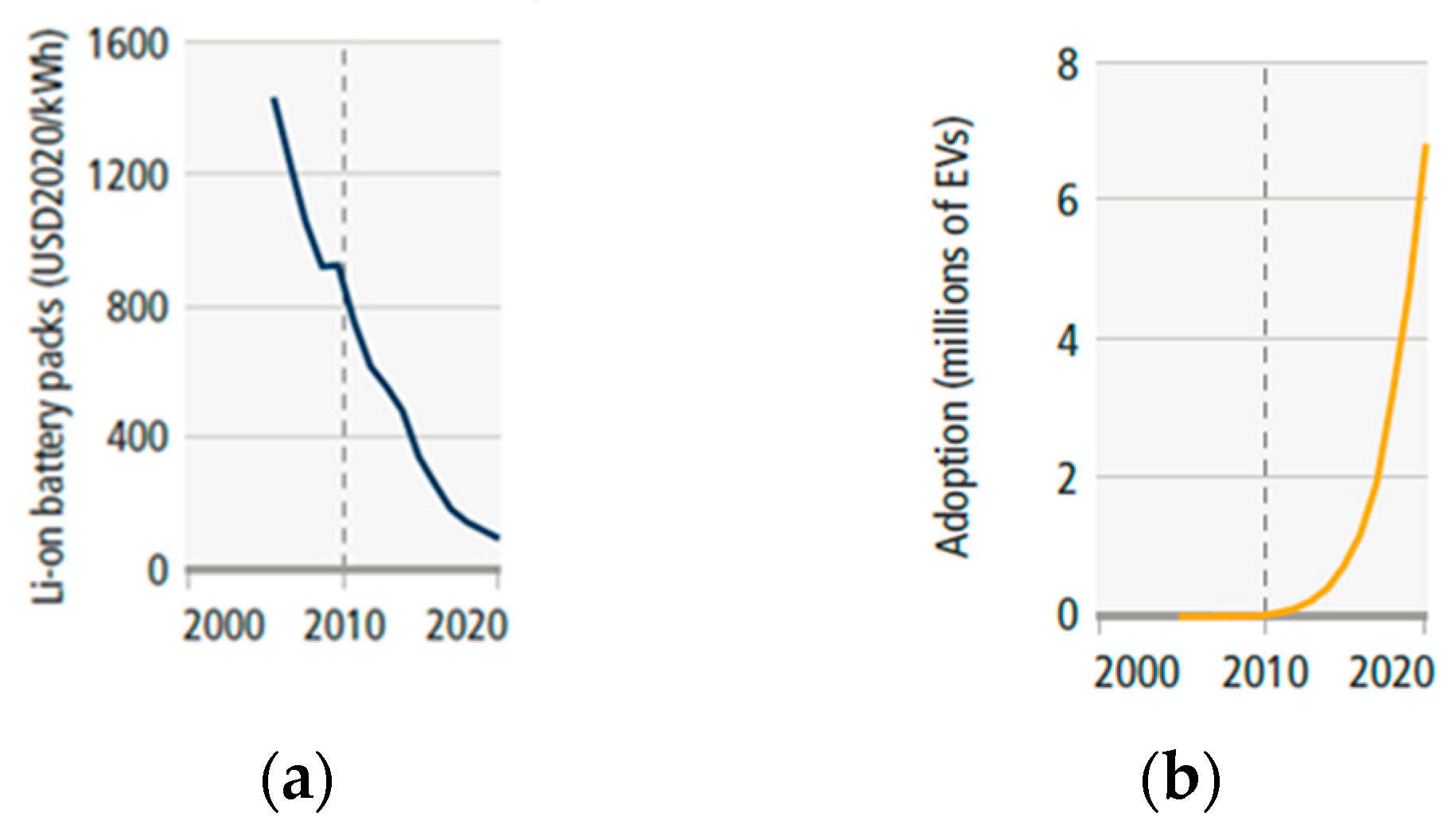
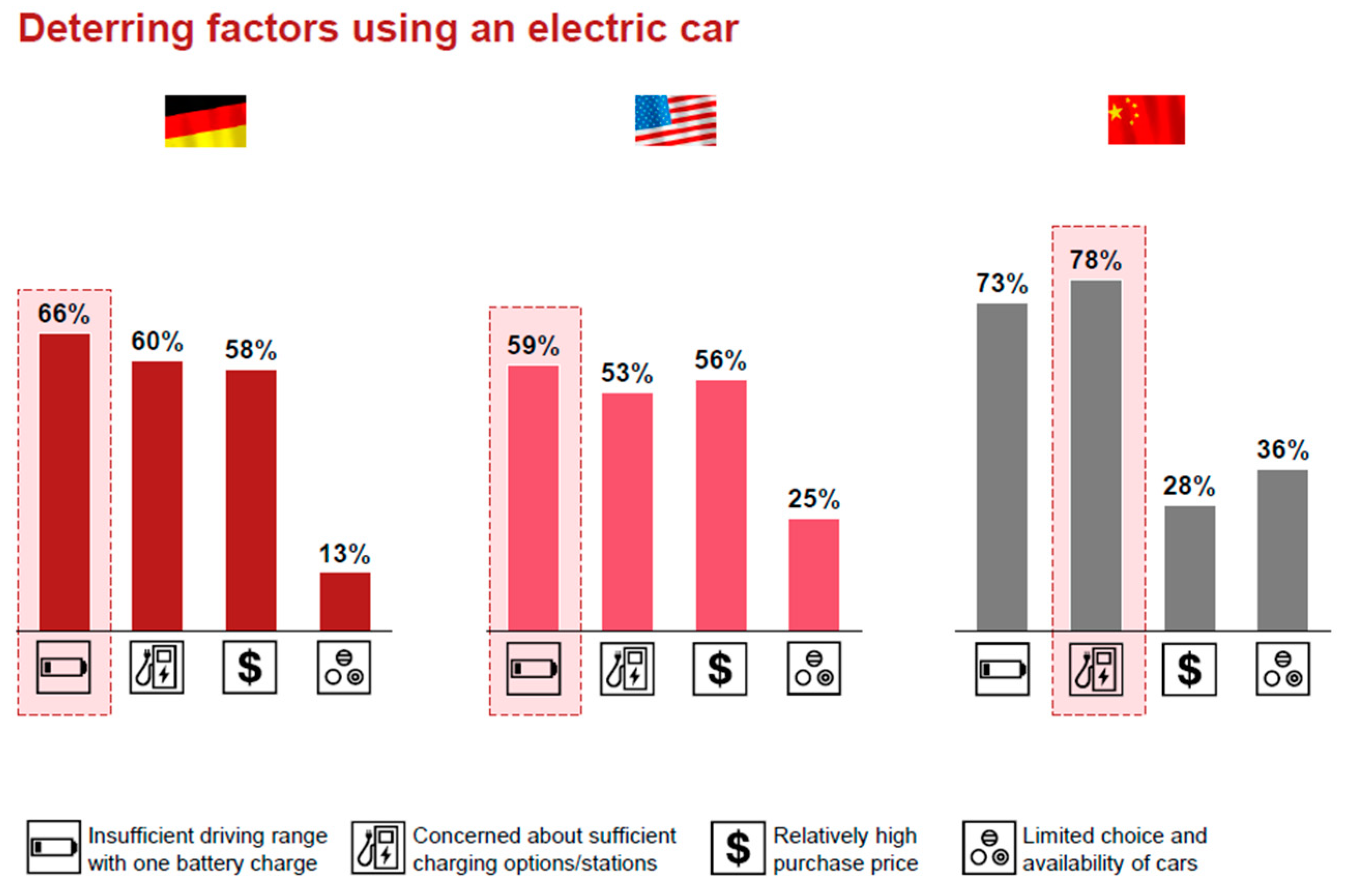
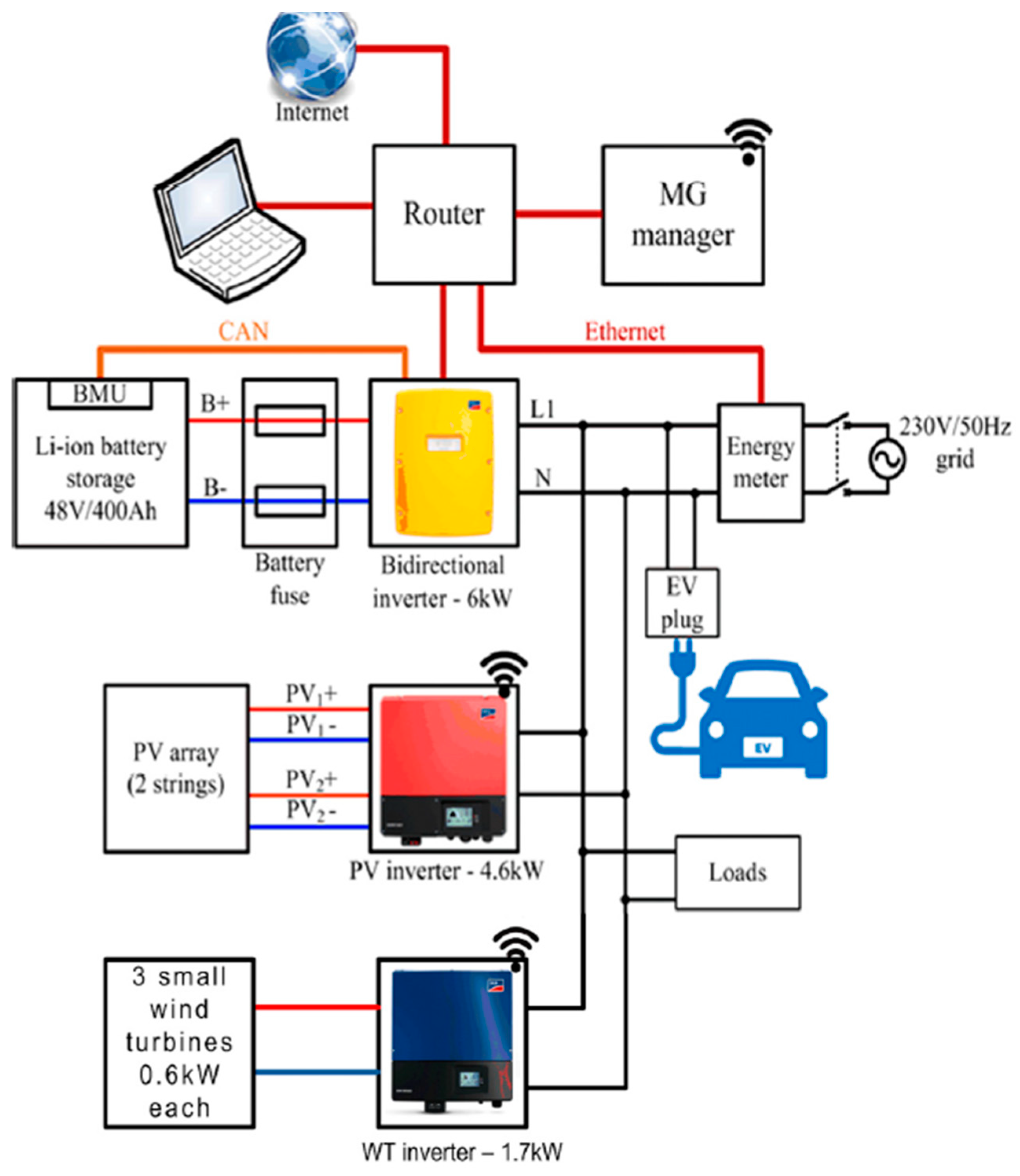



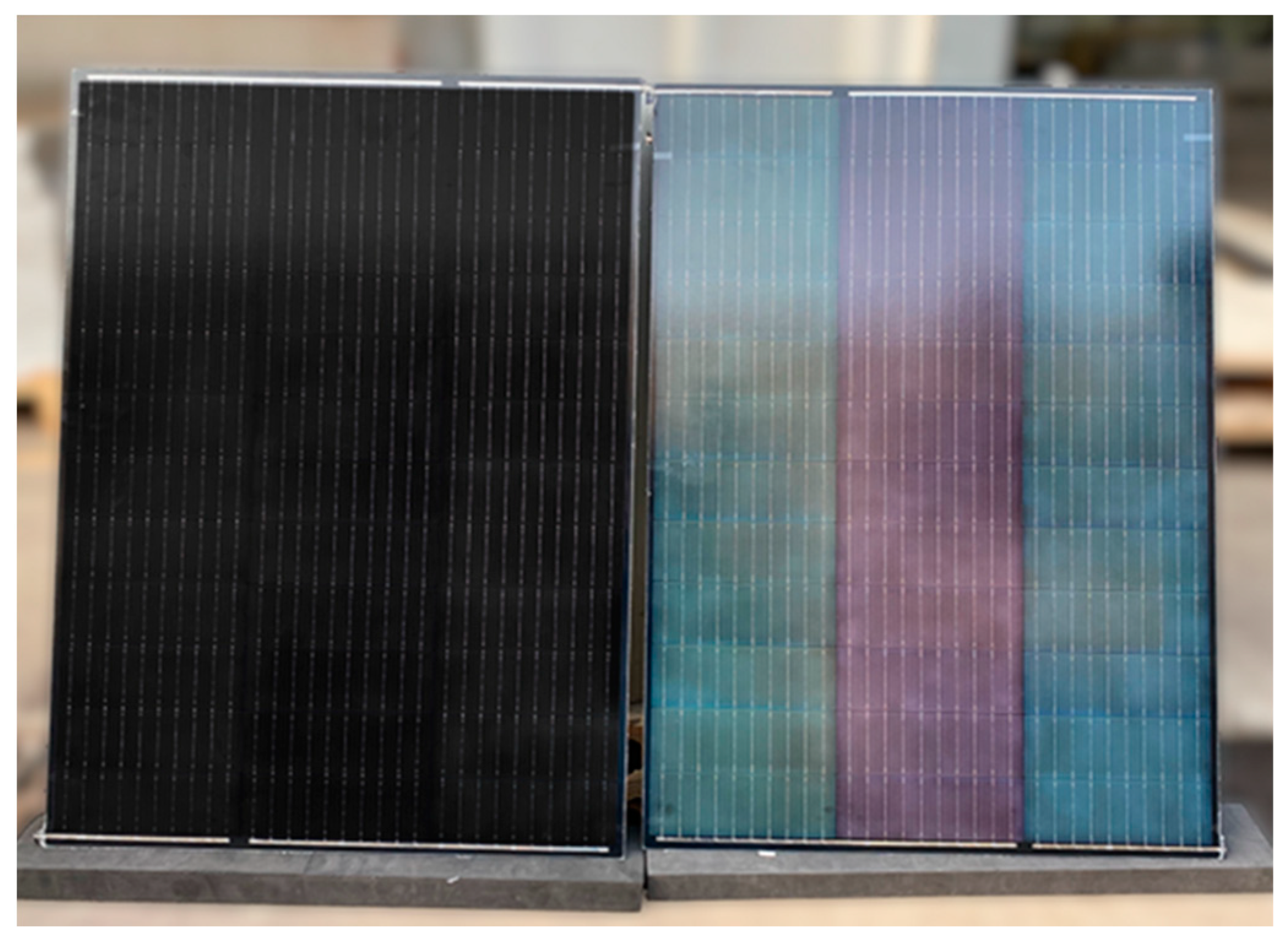
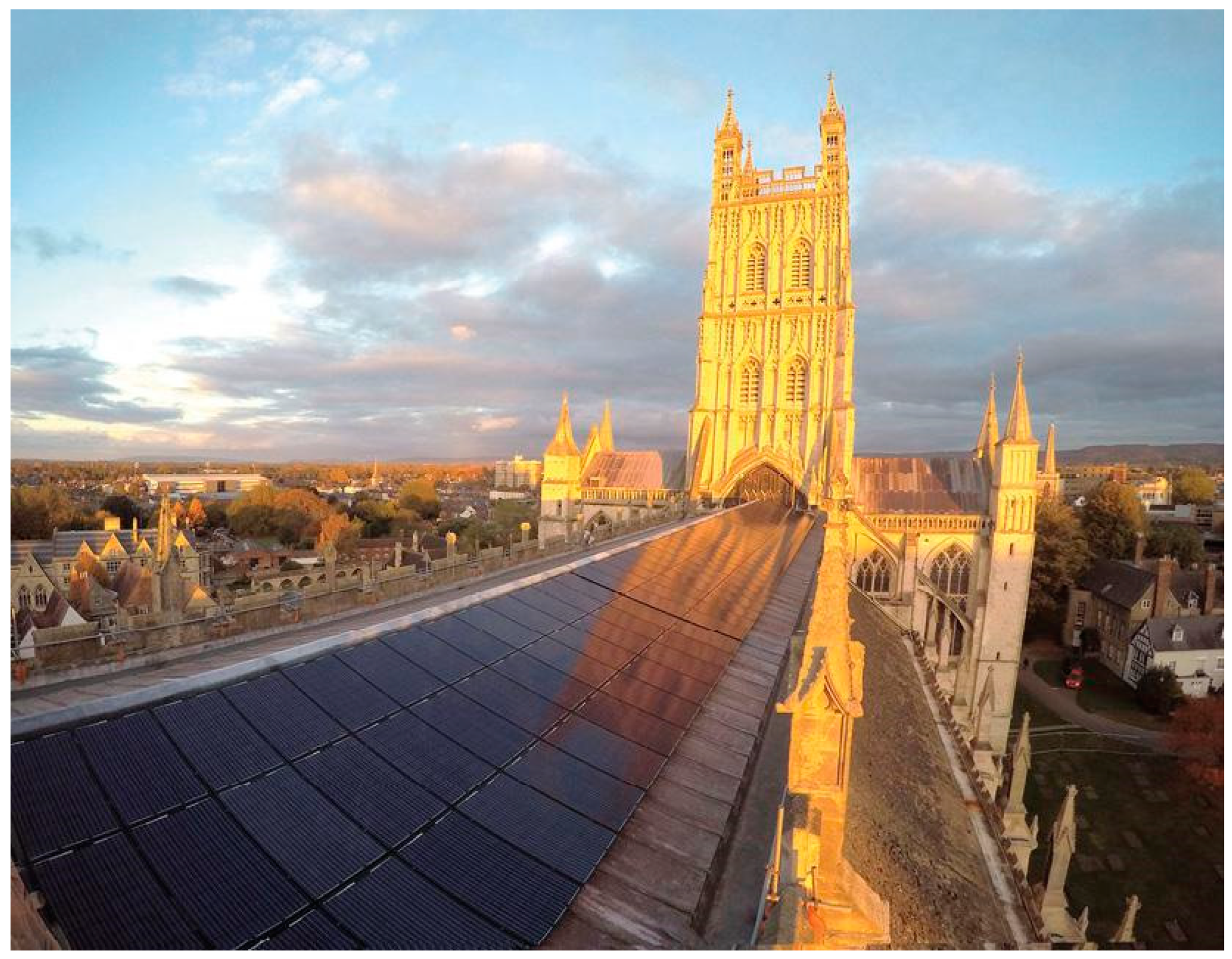


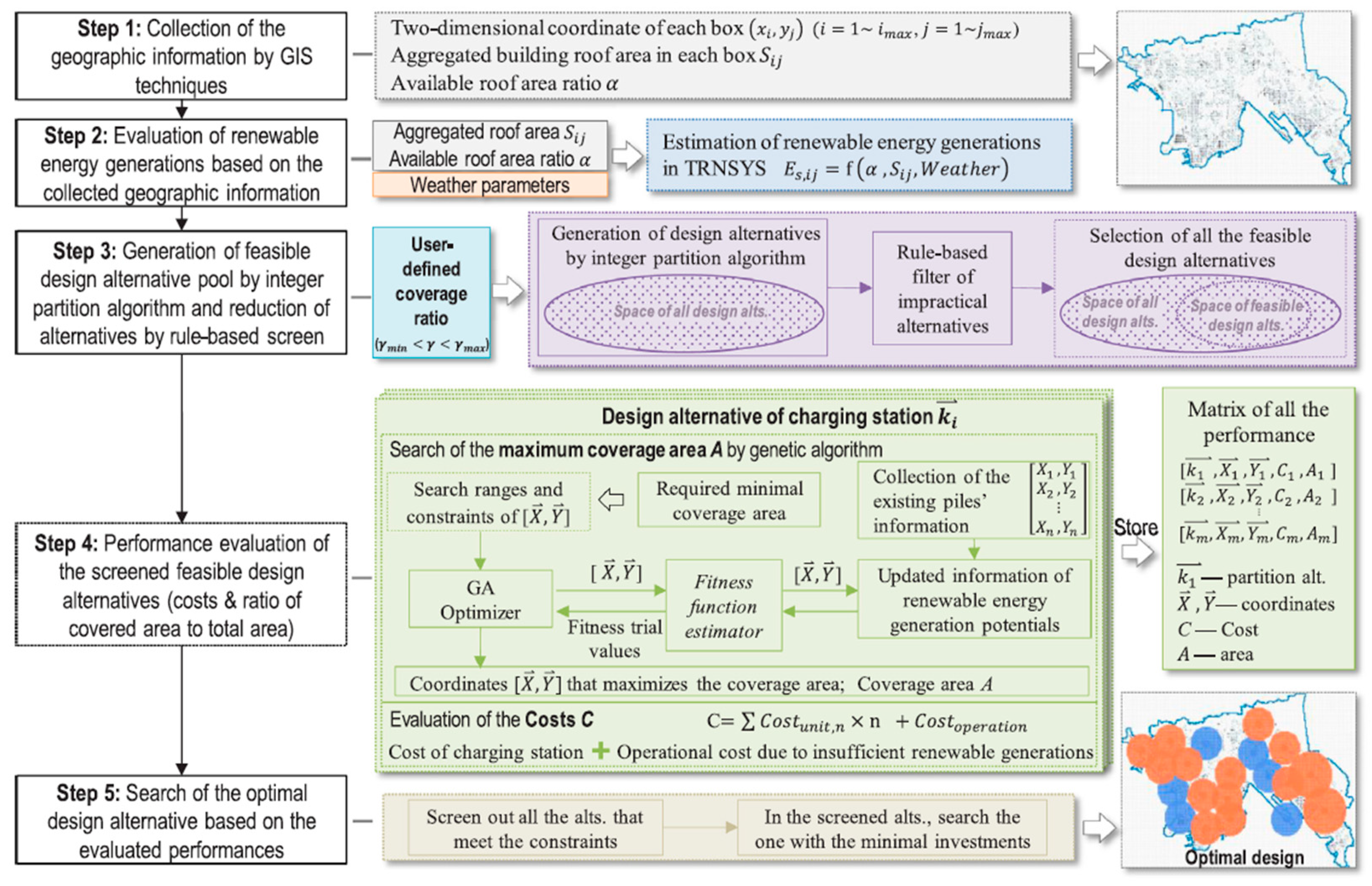

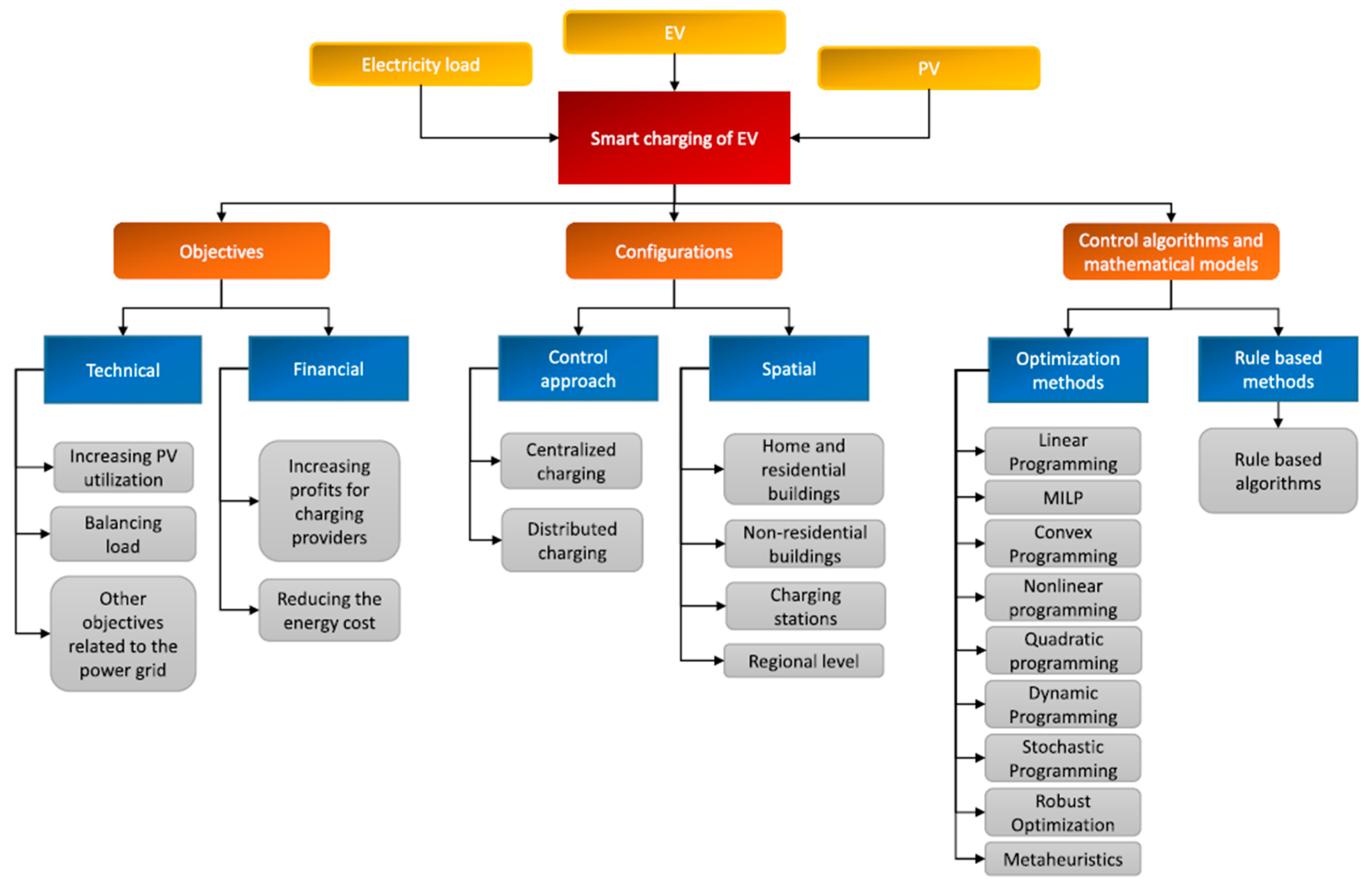


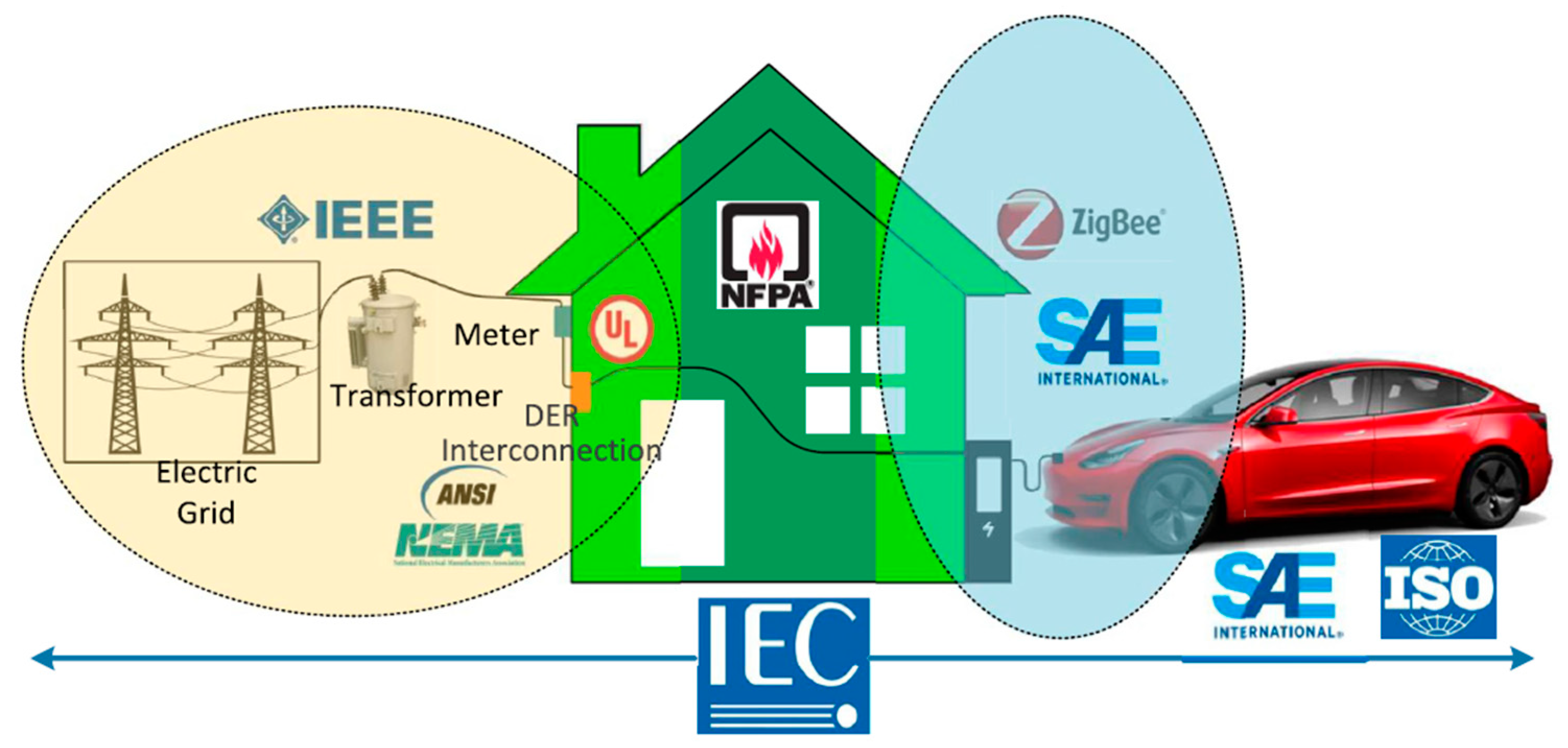
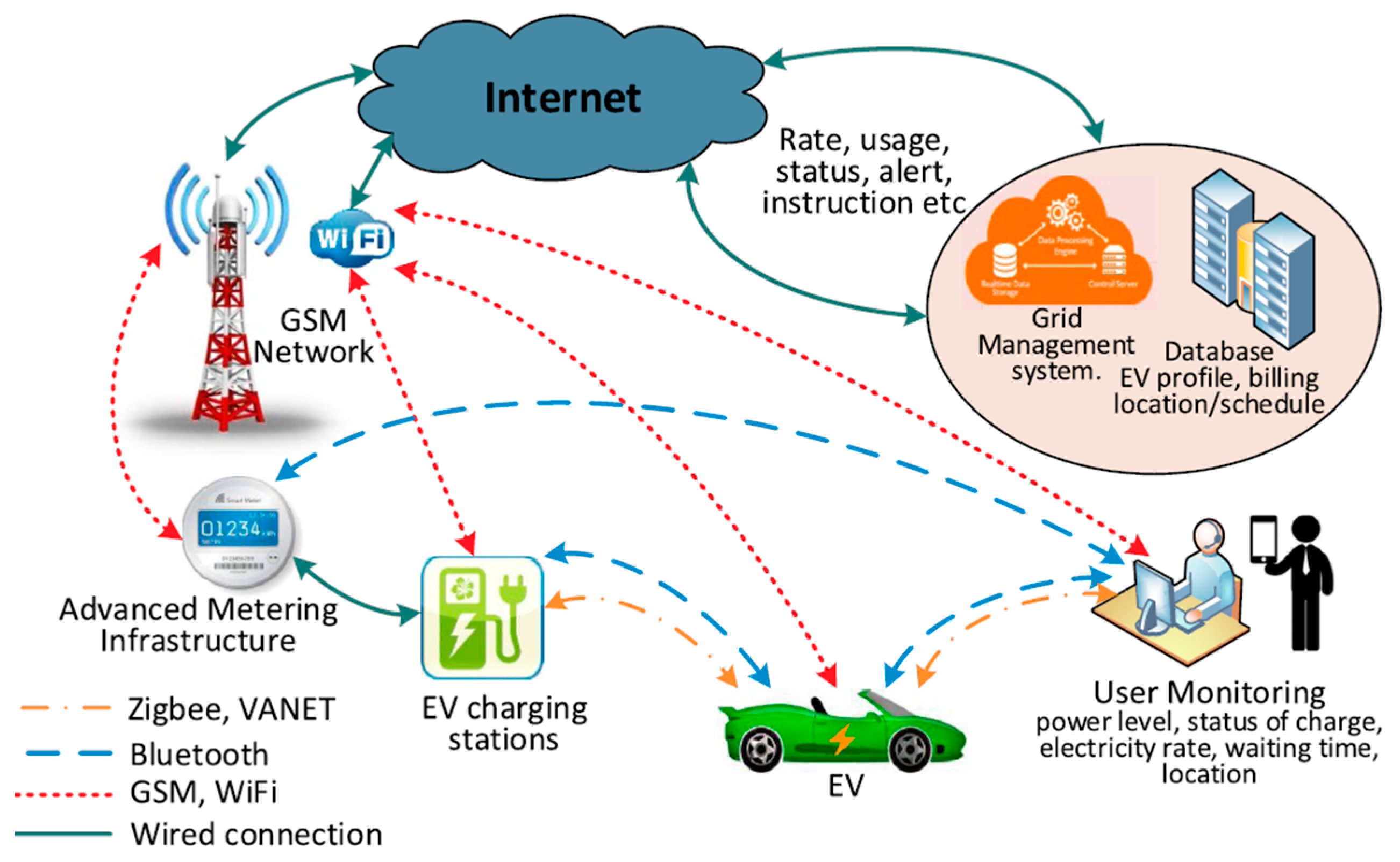

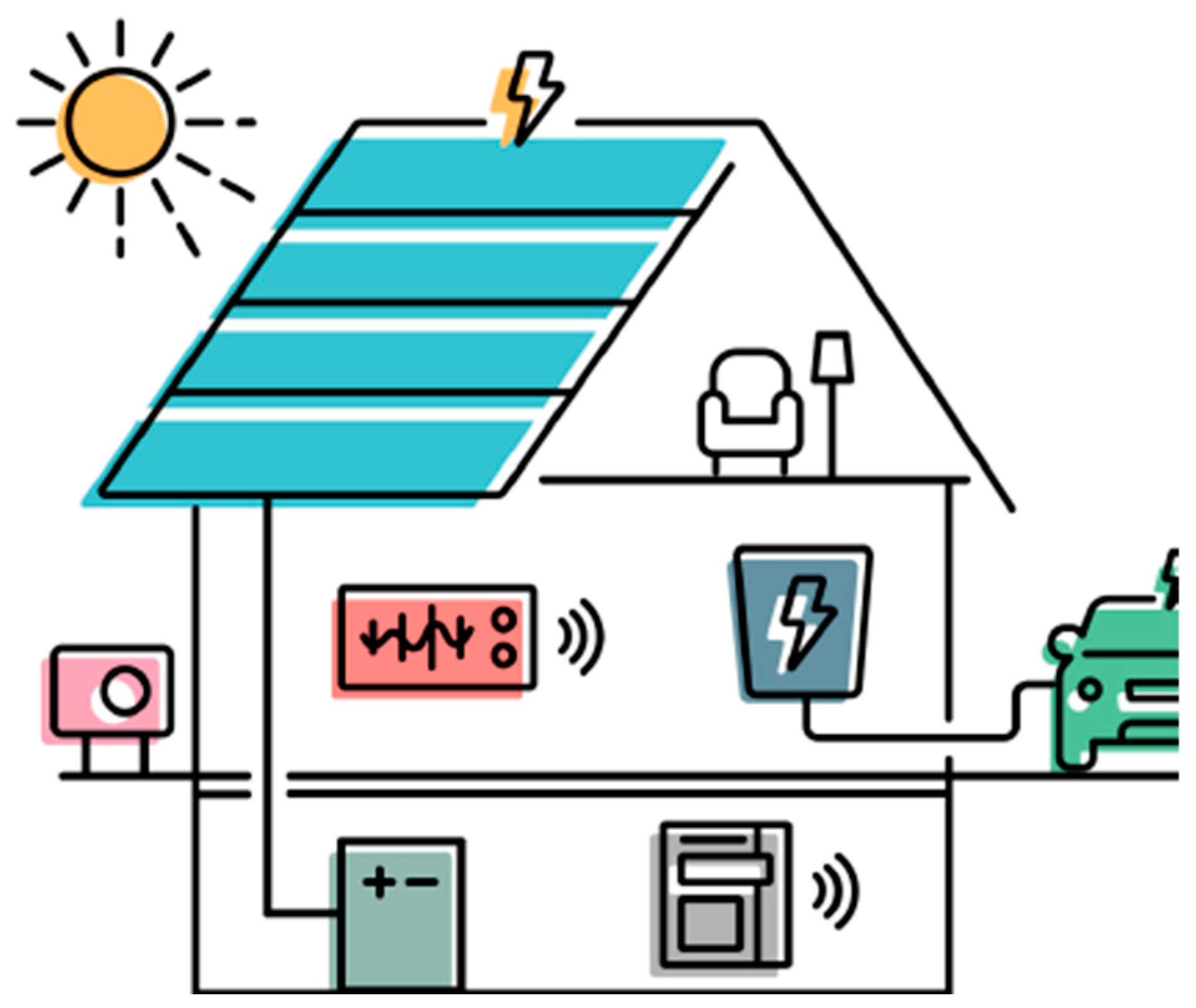
| Type of Cell | Module Efficiency (%) | Application Field |
|---|---|---|
| Monocrystalline Si | 14–20 | Conventional/roof |
| Heterojunction Monocrystalline Si | 26 | |
| Si (amorphous cell) | 10.2 | |
| Polycrystalline Si | 12–16 | Conventional/roof |
| III-V cells | ||
| GaAs (thin film cell) | 29.1 ± 0.6 | BIPV |
| GaAs (multicrystalline) | 18.4 | |
| InP (crystalline cell) | 24.2 | |
| Thin film | BIPV | |
| CIGSSe (submodule) | 19.8 | |
| CdTe (cell) | 21.0 | |
| Others | ||
| Dye (submodule) | 8.8 | |
| Perovskite (minimodule) | 21.4 | Conventional/roof |
| Organic (cell) | 15.2 | BIPV |
| Financial Incentives | Non-Financial Incentives | Supporting Charging Infrastructure | Raising Consumers’ Awareness |
|---|---|---|---|
| Point of sale grant Sale tax and VAT exemptions Post purchase rebates Income tax credits | Other different initiatives | ||
Disclaimer/Publisher’s Note: The statements, opinions and data contained in all publications are solely those of the individual author(s) and contributor(s) and not of MDPI and/or the editor(s). MDPI and/or the editor(s) disclaim responsibility for any injury to people or property resulting from any ideas, methods, instructions or products referred to in the content. |
© 2022 by the author. Licensee MDPI, Basel, Switzerland. This article is an open access article distributed under the terms and conditions of the Creative Commons Attribution (CC BY) license (https://creativecommons.org/licenses/by/4.0/).
Share and Cite
Marinescu, C. Progress in the Development and Implementation of Residential EV Charging Stations Based on Renewable Energy Sources. Energies 2023, 16, 179. https://doi.org/10.3390/en16010179
Marinescu C. Progress in the Development and Implementation of Residential EV Charging Stations Based on Renewable Energy Sources. Energies. 2023; 16(1):179. https://doi.org/10.3390/en16010179
Chicago/Turabian StyleMarinescu, Corneliu. 2023. "Progress in the Development and Implementation of Residential EV Charging Stations Based on Renewable Energy Sources" Energies 16, no. 1: 179. https://doi.org/10.3390/en16010179
APA StyleMarinescu, C. (2023). Progress in the Development and Implementation of Residential EV Charging Stations Based on Renewable Energy Sources. Energies, 16(1), 179. https://doi.org/10.3390/en16010179





